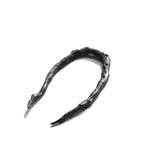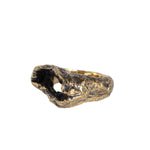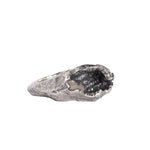Jewelry held profound significance in ancient Egyptian society, spanning both their daily lives and their beliefs about the afterlife. Men and women alike cherished their jewelry pieces, embedding them with religious meanings and symbols.
Because of these deep connections, Egyptians were often buried along with their treasured jewelry. Modern jewelry designers frequently find inspiration in these ancient Egyptian designs.
This fascination is understandable, considering the astonishing craftsmanship of ancient Egyptian artifacts. Let’s explore this ancient culture that continues to captivate us!

The Ancient Egyptian Jewelry History
Importance of jewelry in ancient Egypt:
Jewelry held an important place in various ancient cultures, but this was especially true for ancient Egypt.
Unlike in many other civilizations where only royalty and elites sported jewelry, in ancient Egypt, everyone from peasants to pharaohs adorned themselves with these pieces.
The complexity and elaboration of the jewelry corresponded to the wearer’s social rank. Jewelry played a crucial role in various aspects of Egyptian life, particularly:
- Personal adornment
- Social status
- Religious rituals
Such was the importance of jewelry in Egyptian history that the oldest discovered piece dates back to pre-4500 BC.
Personal adornment
One main reason for wearing jewelry was personal adornment, as ancient Egyptians valued their physical appearance greatly.
Jewelry was integral to an ancient Egyptian’s life from an early age and remained so even after death, with people often being buried wearing their jewelry. Each piece told a unique story and reflected personal style.
The more affluent and pharaohs wore highly detailed pieces, with entire bodies adorned in jewelry.
Social status
Jewelry also served as a symbol of social hierarchy. Higher social status was often indicated by more elaborate and valuable jewelry. Pharaohs and nobles wore gold, copper, and gemstones. Pharaohs would award jewelry as military honors. For example, jewelry unearthed from Nubia included pierced oyster shells inscribed with King Senworset I’s cartouche, likely worn by soldiers during the Middle Kingdom.
Similarly, the “Golden Fly” pendants of the 18th dynasty are another example of military rewards.
Three large gold flies found in Queen Aahhotep’s grave serve as a testament to her military achievements.
Religious rituals, symbolism, and belief systems
Archaeological excavations of royal and non-royal tombs provide much of what we know today about ancient Egyptian jewelry. These finds reveal that jewelry played a pivotal role in religious rituals.
In religious contexts, jewelry was thought to bestow power, protection, and guidance to the deceased in the afterlife. During funeral rites, specific amulets were strategically placed within the mummy’s wrappings.
The symbolic importance of jewelry often depended on its color and form, with different designs corresponding to various deities within the belief system.
Ancient Egyptian Jewelry Facts: Types of Jewelry
The ancient Egyptians adorned themselves with various jewelry pieces, such as
- Necklaces
- Earrings
- Rings
- Bracelets
- Cuffs
Nevertheless, the most iconic jewelry type is associated.
One of the most iconic pieces of jewelry from ancient Egypt is the wide-collar necklace. This broad necklace was designed to cover the neck and stretch from the collarbone to the breast. It typically featured rows of beads shaped like animals or flowers.
In addition to wide collar necklaces, other commonly worn items included protective amulets, heart scarabs, and beaded necklaces.
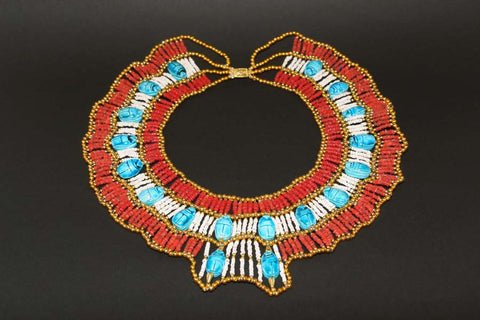
Protective Amulets
Ancient Egyptians wore amulets as a form of protective jewelry. These pieces were believed to be talismans that offered protection or brought good luck to the wearer.
Artisans often carved these protective amulets in the shapes of various animals, each representing different gods from the ancient Egyptian pantheon. Followers of specific gods would wear jewelry symbolizing those deities.
Heart Scarabs
Among the most significant amulets in ancient Egyptian burial customs were heart scarabs. These amulets were typically oval or beetle-shaped.
The heart scarabs were placed over the deceased’s heart before burial, a practice referenced in the Book of the Dead, which describes the weighing of the heart in the afterlife.
In addition to their funerary significance, heart scarabs symbolized rebirth and creation and were often integrated into other jewelry pieces.
Beaded Necklaces
Beaded necklaces were very popular in ancient Egypt due to their affordability, making them accessible to even the poorer members of society.
They were crafted from various materials such as clay, wood, minerals, and semi-precious stones. While wealthier individuals chose more expensive materials, the less affluent used more economical options like clay.
What Was Ancient Egypt Jewelry Made Of
The materials used in ancient Egyptian jewelry included various metals, minerals, and stones. Artisans developed advanced techniques for working with a range of materials.
Excavations of jewelry workshops have provided insights into the craftsmanship of ancient Egyptian jewelers. The most extensive knowledge about these techniques and materials comes from tomb scenes. Depending on their purpose and the wearer’s social standing, these pieces were made from various materials.
Gold and Other Metals
Gold was the predominant material in ancient Egyptian jewelry and was typically reserved for royalty and those of high social status. Other metals included copper and, more rarely, silver.
Both aristocrats and royal families adorned themselves with gold jewelry, and gold was also used to embellish statues of the gods. The pharaohs’ headdresses, beads, and other jewelry items were often crafted from gold.

Wooden and Ceramic Beads
The ancient Egyptians crafted beads from wood, ceramics, and valuable metals and stones for their:
- headdresses
- neckpieces
- bracelets
Egyptian faience, a material combining clay with sand, limestone, soil, dirt, and water, allowed artisans to create glossy, hardened sculptures and animal figurines. Faience beads were highly prized in ancient Egypt.
Precious and Semi-Precious Gemstones
Gemstones like carnelian, turquoise, and lapis lazuli typically adorned royal jewelry. Following the tradition of ancient Egyptian jewelry masters, turquoise stones are prominently featured in our jewelry pieces.
Stones held significant importance in ancient Egyptian history. Lapis lazuli, known for its deep blue tones, was particularly popular.
The use of various stones was widespread in ancient Egyptian jewelry.
vivid brownish-red carnelian stone. It was once believed that wearing carnelians shielded the wearer from ‘the evil eye’.
Techniques Used: How Was Ancient Egyptian Jewelry Made?
Cartouches
A cartouche is an oval that encloses hieroglyphs, forming a name or title, often found on rings. These jewelry pieces served to name Pharaohs.
The technique of using cartouches flourished in ancient Egypt, driven by the belief that writing a person’s name granted them immortality.
Rings using the cartouche technique were early iterations of signet rings, which Pharaohs employed to seal important documents.
Signet rings remain popular today, inspiring us to consistently introduce new designs into our collections.
Hieroglyphics
Ancient Egyptian jewelry often includes hieroglyphs, which provide valuable information about the period and owners of the pieces.
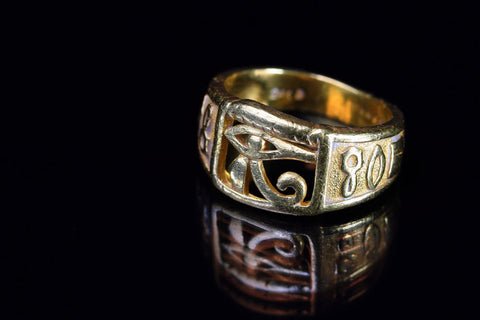
Deities and Iconography
Pharaohs adorned themselves with headdresses, amulets, rings, and pendants depicting revered deities. Ancient Egyptian jewelry frequently features gods like Horus, Set, Ra, and the goddess Isis.
Popular among household deities were Bes and Taweret. Bes was believed to protect households, specifically mothers, children, and childbirth.
Taweret, depicted as a bipedal hippopotamus, was thegoddess safeguarding childbirth and fertility. Modern jewelry still often incorporates animal motifs for both spiritual and artistic purposes.
Conclusion
Ancient Egypt boasts one of the most enriched civilizations artistically and culturally. The history of Ancient Egyptian jewelry is immensely varied and vibrant, emphasizing both adornment and spirituality.









































